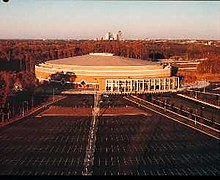Charlotte Coliseum
| The Hive | |

The Coliseum in 1988
|
|
| Location | 100 Paul Buck Boulevard Charlotte, North Carolina 28266 |
|---|---|
| Coordinates | 35°11′11″N 80°54′46″W / 35.18639°N 80.91278°WCoordinates: 35°11′11″N 80°54′46″W / 35.18639°N 80.91278°W |
| Owner | City of Charlotte |
| Operator | City of Charlotte |
| Capacity |
Basketball: 24,042 *End stage 180°: 16,695 *End stage 360°: 23,780 *Center stage: 24,041 *Theatre: 5,372 - 9,696 |
| Field size | 872,000 square feet (81,000 m2) |
| Construction | |
| Broke ground | August 1986 |
| Opened | August 11, 1988 |
| Closed | October 26, 2005 |
| Demolished | June 3, 2007 |
| Construction cost | US$52 million ($105 million in 2016 dollars) |
| Architect | Odell Associates |
| Tenants | |
|
Charlotte Hornets/Bobcats (NBA) (1988–2002, 2004–05) Charlotte 49ers (NCAA) (1988–1993) Charlotte Rage (AFL) (1992–1996) Charlotte Sting (WNBA) (1997–2005) Carolina Cobras (AFL) (2003–2004) |
|
Basketball: 24,042
Ice hockey: 21,684
Boxing: 23,041
Charlotte Coliseum was a multi-purpose sports and entertainment arena located in Charlotte, North Carolina. It was operated by the Charlotte Coliseum Authority, which also oversees the operation of Bojangles' Coliseum (which was called Charlotte Coliseum prior to 1988), the Charlotte Convention Center, and Ovens Auditorium. It is best known as the home of the NBA's Charlotte Hornets from 1988 to 2002, and the Charlotte Bobcats (now the second incarnation of the Hornets) from 2004 to 2005.
The Coliseum hosted 364 consecutive NBA sell-outs from December 1988 to November 1997. It hosted its final NBA basketball game on October 26, 2005, a preseason game between the Charlotte Bobcats and the Indiana Pacers.
The city of Charlotte sold the property, and the building was demolished via implosion on June 3, 2007. A mixed-use development is currently under construction at the property.
Construction on the Charlotte Coliseum began in 1986 and was opened on August 11, 1988 with a dedication by the Rev. Billy Graham. At the time the venue was seen as state-of-the-art, complete with luxury boxes and a large eight-sided video scoreboard. George Shinn had used the under-construction arena as his hole card to get the NBA to place a team in the city. With almost 24,000 seats, it was not only the largest venue in the league, but the largest basketball-specific arena ever to serve as a full-time home for an NBA team. Some thought the Coliseum was too big, but Shinn believed the area's longstanding support for college basketball made the Coliseum a more-than-viable home for an NBA team.
...
Wikipedia
